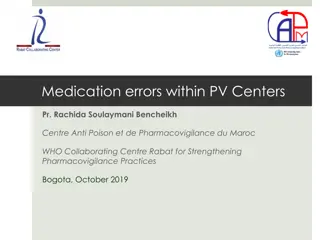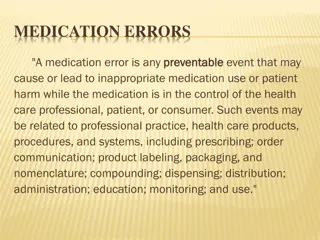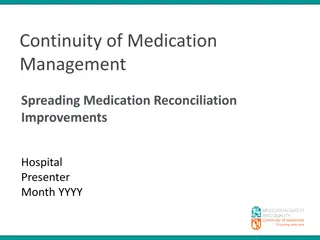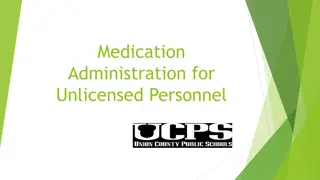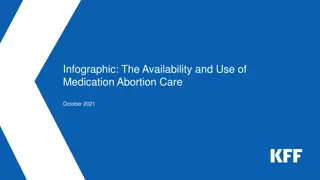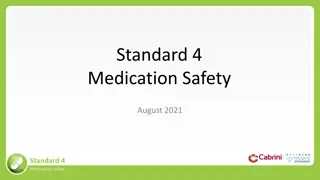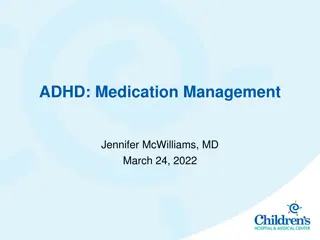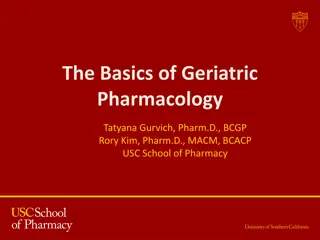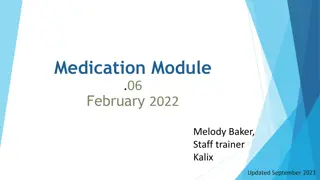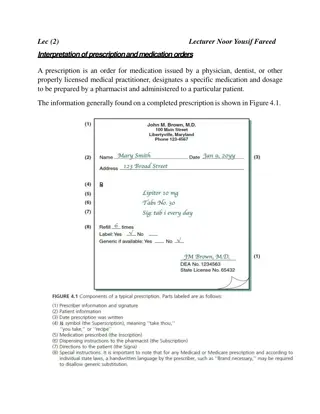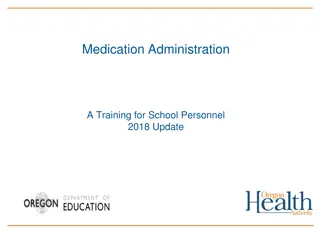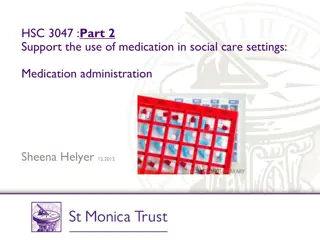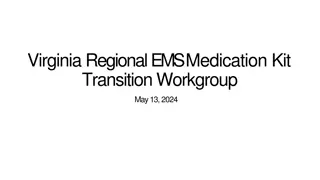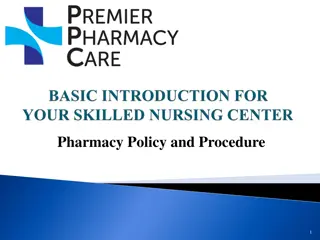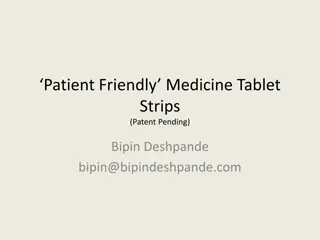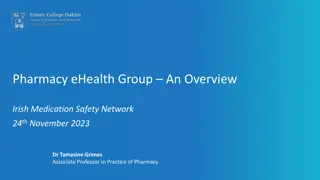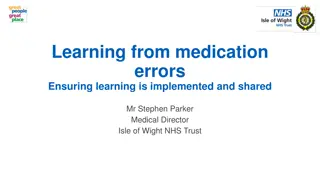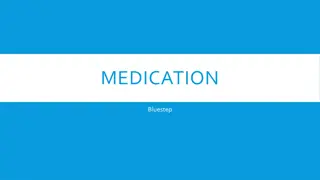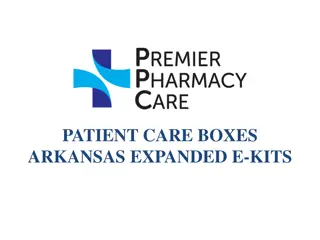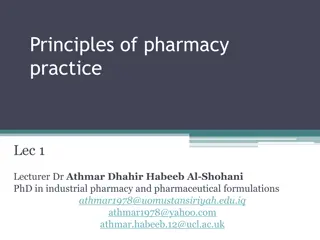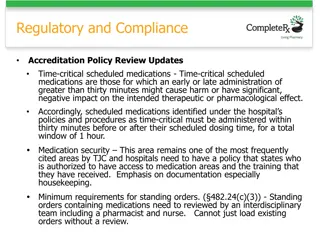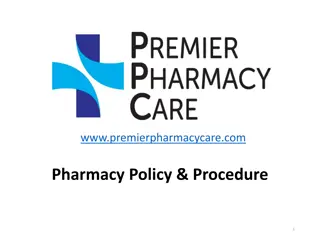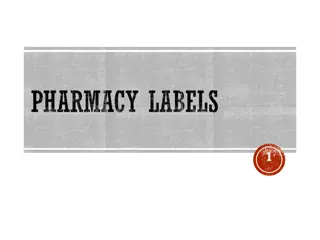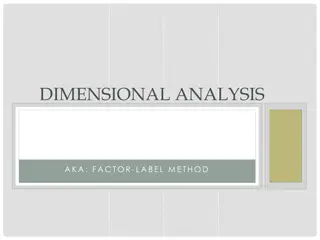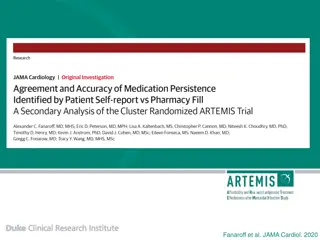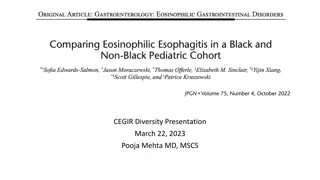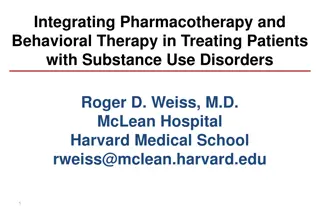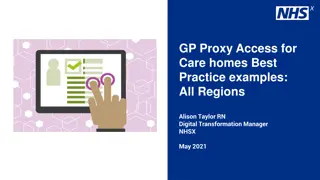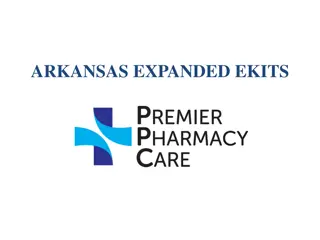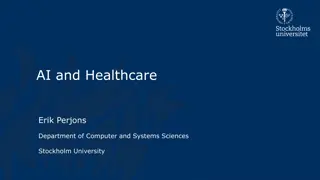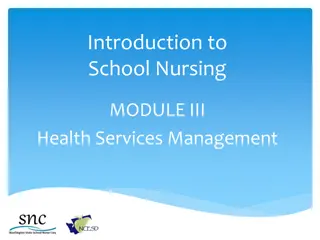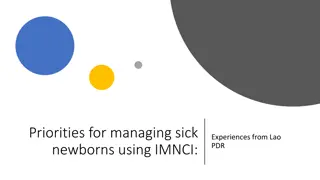Improving Medication Management in Healthcare
This Congressional briefing highlights the importance of getting medications right for achieving the goals of the Medicare Better Care, Lower Cost Act. It emphasizes Comprehensive Medication Management (CMM) and Team-Based Care, showcasing the efforts of healthcare professionals in Fairview Health Services to optimize medication use. The presentation addresses the challenges of medication adherence, the impact of improper medication use on the healthcare system, and the role of healthcare providers in ensuring proper medication management.
- Medication management
- Healthcare
- Congressional briefing
- Fairview Health Services
- Comprehensive Medication Management
Download Presentation

Please find below an Image/Link to download the presentation.
The content on the website is provided AS IS for your information and personal use only. It may not be sold, licensed, or shared on other websites without obtaining consent from the author. Download presentation by click this link. If you encounter any issues during the download, it is possible that the publisher has removed the file from their server.
E N D
Presentation Transcript
U.S. House of Representatives Congressional Briefing Getting the Medications Right : An essential ingredient in achieving the goals of H.R. 4878 the Medicare Better Care, Lower Cost Act Sponsored by Representatives Eric Paulsen (R-MN) and Peter Welch (D-VT) Minnesota Presenters: Amanda Brummel, Pharm.D., BCACP Director, Clinical Ambulatory Pharmacy Services Fairview Health Services Minneapolis, MN Vermont Presenters: Amanda Kennedy, Pharm.D., BCPS Pharmacist Clinician University of Vermont Medical Center Burlington, VT Mary M. Figueroa, M.D. Family Physician Fairview Medical Group Edina, MN Charles D. MacLean, M.D. Associate Dean for Primary Care and Professor of Medicine University of Vermont Medical Center Essex Junction, VT
Comprehensive Medication Management (CMM) and Team Based Care Amanda Brummel, PharmD, BCACP Mary Figueroa, MD May 18,2016
Who is Fairview Health Services? By the Numbers 1906 Fairview is established as a nonprofit 1997 Fairview partners with the University of Minnesota 20,000+ Fairview employees across Minnesota 3,052 Credentialed physicians 7 Hospitals/medical centers 1,602 Staffed beds 45+ Primary care clinics 55+ Specialty clinics 47 Senior housing locations 30+ Retail pharmacies 30+ CMM practices
Our Care Team Primary Care Provider Care Health Coach Coordination CDE- Certified Diabetes Educator Comprehensive Medication Management (CMM) RN (disease management) Behavioral Health Clinician
The Facts Almost 50% of people prescribed a medication for chronic conditions do not take them correctly. Nearly 70% of Americans are on at least one prescription drug and over 50% of Americans are on at least two prescription drugs. Forty percent take 5-9 medications. 31% of prescriptions written are not filled A.J. Claxton et al. A Systematic Review of the Associations Between Dose Regimens and Medication Compliance. Clinical Therapeutics, August 2001. Zhong, W. et al. (2013). Age and sex patterns of drug prescribing in a defined American population. Mayo Clinic Proceedings, 88(7). www.bu.edu/slone/files/2012/11/SloneSurveyReport2006.pdf Tamblyn, Robyn. The Incidence and Determinants of Primary Nonadherence With Prescribed Medication in Primary Care Ann Intern Med. 2014; 160(7).
The financial stats Improper medication use by patients has been estimated to cost the health system up to $290 billion a year Prescriptions drugs comprise 9.8% of healthcare expenditures This represents the third most costly component of the nation s health spending behind hospital care (32%) and physician and clinical services (20%) http://www.nehi.net/writable/publication_files/file/pa_issue_brief_final.pdf http://www.cdc.gov/nchs/fastats/health-expenditures.htm- 2014 data
Spectrum of pharmacist practice Comprehensive Medication Management (CMM) Care Transitions Integrated Database Analysis Medication utilization/safety/gaps in care Medication/Disease Therapy Management Community Pharmacy Clinical Interventions
Comprehensive Medication Management Built upon the philosophy and process of pharmaceutical care practice ESTABLISH A THERAPEUTIC RELATIONSHIP ASSESSMENT CARE PLAN EVALUATION Record actual patient outcomes Ensure all drug therapy is indicated, effective, safe and convenient Resolve drug therapy problems Evaluate progress in meeting therapeutic goals Establish therapeutic goals Identify drug therapy problems Prevent drug therapy problems Reassess for new problems Continuous Follow-up Working in collaboration with all members of the healthcare team
Drug Therapy Problems, 2015 20,061 Drug Therapy Problems Identified Dosage Too Low Needs Additional Drug Therapy Noncompliance Adverse Drug Reaction Dosage Too High Unnecessary Drug Therapy Ineffective Drug 31 % 23 % 14 % 10 % 9 % 7 % 6 %
Patient Story TL was seen by the pharmacist after a recent hospitalization (post MI) He quit all of his medications due to perceived side effects He had 3 different boxes of Rx bottles He takes at least 17 different supplements Pharmacist reviewed all meds. Educated him on post MI guidelines. Restarted appropriate meds, initiating them slowly. Following up to ensure he is taking them correctly. He was taking 2 statins and Red Yeast Rice No Aspirin No blood pressure meds
Patient Story SA was seen by the pharmacist for diabetes management (A1c 9.8%) Insulin was continuously being increased with no improvement to her A1c Patient was frustrated with her weight and she felt exhausted Patient saw the pharmacist. New medication for DM was started. Patient lost 16lbs and A1c improved to 6% Were able to reduce other medications Quality of life increased- more energy and she is now exercising
Fairview Published Results Focus on clinical, humanistic and economic data An average 12-to-1 return on investment in terms of reduced overall health-care costs, documented in Clinical and Economic Outcomes of Medication Therapy Management Services: The Minnesota Experience (Isetts, et al., J Am Pharm Assoc. 2008;48(2):203-211) MTM contributed to optimal care in complex patients with diabetes documented in Optimal Diabetes Care Outcomes Following Face-to-Face Medication Therapy Management Services (Brummel A.R. et al, Population Health Management: 2012) Medication therapy management: 10 years of experience in a large integrated health care system. (Ramalho de Oliveira, D., Journal of Managed Care Pharmacy : JMCP, 16(3), 185-195.)
Fairview Published Results Focus on clinical, humanistic and economic data Provider s Perceptions: Maracle, H.L., Primary Care Providers' Experiences with Pharmaceutical Care-based Medication Therapy Management Services. Innovations in Pharmacy: 3(1) 72. Patient s Perceptions: Schultz, H., Patient-perceived value of Medication Therapy Management (MTM) services: a series of focus groups. Innovations in Pharmacy:3(4)96
Health Care Costs After CMM $12,000 $10,000 1 Year before CMM $8,000 $6,000 1 Year after CMM $4,000 $2,000 $0 Facilities (-57.9%) Professional (-11.1%) Prescriptions (+ 19.5%) Total Cost (-31.5%) (Isetts, et al., J Am Pharm Assoc. 2008;48(2):203-211)
Optimal Diabetes Care Outcomes Following CMM 80 70 60 50 2006 40 2007 30 2008 20 10 0 CMM Group- Optimal Care Non- CMM Group- Optimal Care CMM- A1c Non- CMM A1c Brummel A.R. et al, Population Health Management: 2012
Keys to Success in Team Based Care Every team member working to the top of licensure All team members working & communicating with each other, understanding each other s expertise, to meet the needs of a population Developing teams and showing that teamwork to patients Developing hardwired processes to access additional team members when patients aren t meeting goals
Amanda Brummel PharmD, BCACP Director, Clinical Ambulatory Pharmacy Services Fairview Pharmacy Services 711 Kasota Ave SE | Minneapolis, MN 55414 arhode1@fairview.org | www.fairviewmtm.org Mary Figueroa, MD Provider, Fairview Edina Clinic Fairview Medical Group mfiguer1@Fairview.org I www.fairview.org
Getting the Medications Right: An essential ingredient in achieving the goals of H.R. 4878 the Medicare Better Care, Lower Cost Act UPDATES FROM VERMONT Amanda G. Kennedy, PharmD, BCPS and Charles D. MacLean, MD U.S. House of Representatives Congressional Briefing May 18, 2016
Chronic Conditions are Common and Costly 25% of all Americans and 66% of older Americans have multiple chronic conditions. Treatment for this population accounts for 66% of the country s health care budget. 46% of patients also use over-the-counter medications and 52% use dietary supplements. % Therapeutic Prescription Drug Use Within the Last 30 Days, 2009-2012 100 90 80 70 60 50 40 30 20 10 0 1 prescription drug 3+ prescription drugs 5+ prescription drugs All Ages Age 65+ Centers for Disease Control and Prevention. The State of Aging and Health in America 2013. Atlanta, GA: Centers for Disease Control and Prevention, US Dept of Health and Human Services; 2013. National Center for Health Statistics. Health, United States, 2015: With Special Feature on Racial and Ethnic Health Disparities. Hyattsville, MD. 2016. Qato DM, Alexander GC, Conti RM, Johnson M, Schumm P, Lindau ST. Use of prescription and over-the-counter medications and dietary supplements among older adults in the United States. JAMA. 2008;300:2867 2878.
Vermont Blueprint for Health Multi-payer payment reform with financial incentives Supports Patient Centered Medical Homes oCommunity Health Teams to augment primary care Community-based implementation Quality Improvement infrastructure Health Information Technology for managing individuals and populations Collaboration with ACO efforts Vermont Blueprint for Health 2015 Annual Report http://blueprintforhealth.vermont.gov/reports_and_analytics/annual_reports
Demonstration Project Aim: To improve care for Vermonters, specifically by optimizing medication regimens, or getting the medications right in primary care Funded by the Vermont Department of Health Selected 5 primary care practices from multiple counties Co-located pharmacists within the primary care medical home practices Activities included a mix of education, direct patient care, and population-based medication management
Pharmacists Role in Primary Care Direct Patient Care Population Management Patient and Prescriber Education Seeing patients in the primary care practice to identify and resolve medication therapy problems Using electronic health record data to identify and resolve medication therapy problems across the practice Being available in the practice to answer medication questions from prescribers and patients
Example of a Pharmacists Practice in the Primary Care Clinic Provide Direct Identify the Problem Educate Prescribers Access Clinic Data Manage the Clinic Population Patient Care Proton Pump Inhibitors (PPIs) are commonly prescribed and are unsafe for long-term use in some patients Educate the prescribers about the dangers of PPI overuse and collaborate on a management approach Use the electronic health record to generate a list of all patients in the practice Meet with patients to help safely discontinue PPI, and document progress in the patient s record. Evaluate patients who may be candidates to taper and discontinue PPIs
Top Medications and Problems Pharmacist-Identified Problem Dosage Too High Non-Adherence Unnecessary Therapy Different Medication Needed Need Additional Therapy % Medication Category % 21% 15% 14% 10% 7% Mental Health and Insomnia Cardiovascular and Diabetes GI/Heartburn Asthma/Allergy Anticoagulants 25% 25% 15% 10% 4% $2 health care costs avoided for every $1 spent on a pharmacist integrated into primary care
Summary Pharmacists are medication experts, but are relatively underutilized in primary care Demonstration project provided direct evidence of how getting the medications right improved the effectiveness and safety of medications for Vermont primary care patients Prescribers and other medical home team members perceived the pharmacists as having value to the practice and the patients they serve As health care reform efforts shift to more accountable models, the economic argument for involving pharmacists will be even easier to realize


